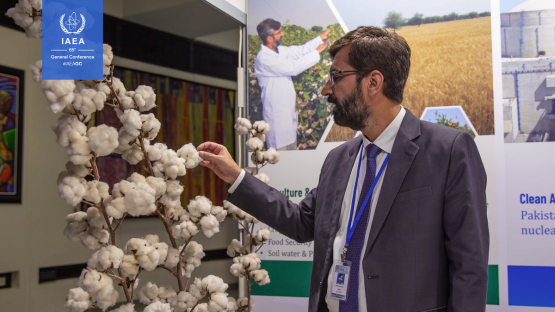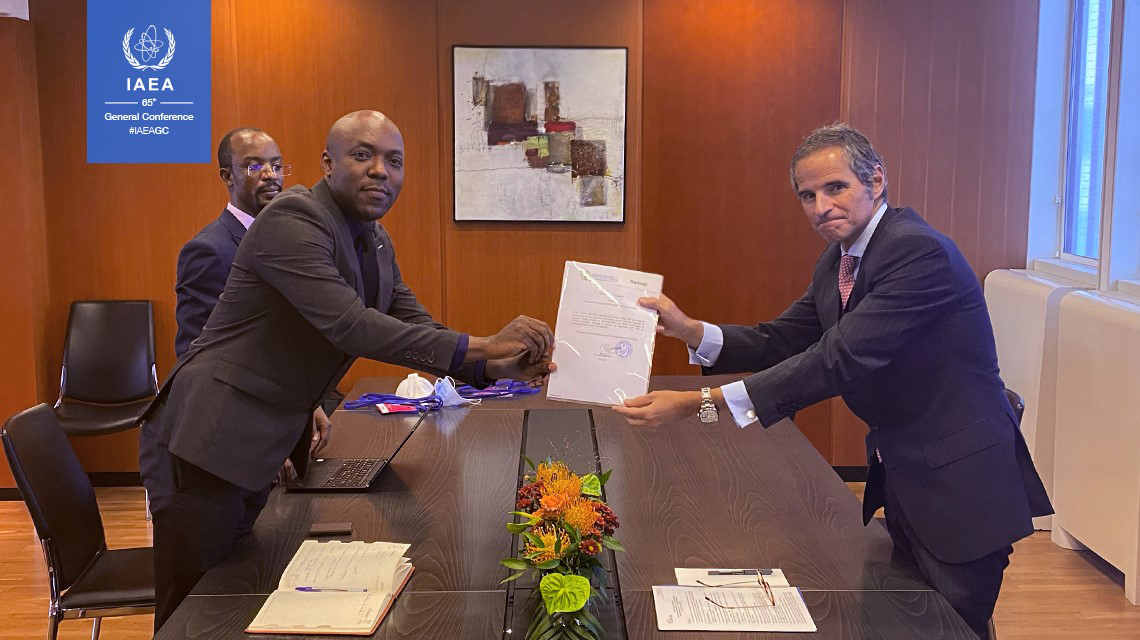Eleven countries have been newly elected to serve on the 35-member IAEA Board of Governors for the period 2021-2022.
General Conference: Day 4 Highlights
A number of countries featured exhibitions at this year’s General Conference. Scientist Muhammed Kashif Riaz Khan (pictured) shows a cotton tree grown with the help of nuclear techniques, at an exhibit hosted by Pakistan. (Photo: F. Llukmani/IAEA)
The following side events took place on Thursday:
At the event Safeguarding the Nuclear Future: Small Modular Reactors participants gained insights into how safeguards considerations apply to Small Modular reactors (SMRs), and how they could be integrated into the SMR design process. They also discussed the importance of working with the IAEA at an early stage to ensure that a country’s international safeguards obligations can be met as effectively and efficiently as possible.
The draft IAEA Nuclear Energy Series Guide on spent fuel storage options and systems for commercial power reactor fuels was presented at the event Spent Fuel Storage Options: Challenges and Solutions. Participants were given an overview of available storage systems and their main characteristics.
How fission technology can benefit fusion technology development and how this knowledge could be made available was the focus of the event Fission Supporting Fusion Technology Development. As ITER’s experiment start-date to create plasma comes closer to fruition, the IAEA is working to facilitate sharing of relevant experience in technology development for electricity production.
Participants at An Interactive Session to Explore Electricity Sector Decarbonization with PowerInvest undertook the challenge of setting a hypothetical country’s electricity generating mix, optimizing emissions reduction, costs and supply reliability.
A new IAEA model for the assessment of integrated electricity systems, Framework for Modelling Electricity Systems (FRAMES), was presented at the event Analysis of Sustainable Integration of Nuclear and Renewable Existing and Future Power Systems: Framework for Modelling Electricity Systems. The framework aims to support countries’ efforts in decarbonizing electricity systems by quantifying the value that nuclear brings to low-carbon systems, like nuclear-renewable hybrid systems.
At the event Enhancing Human Resource Development in Nuclear Science and Technology participants were given an overview of the results achieved to date regarding ongoing long-term training programmes in Africa. Participants discussed future actions and modalities to further enhance human resource development in this area in Africa.
A new coordinated research project to be launched by the IAEA in March 2022 was presented at the event Nuclear–Renewable Integrated Energy Systems: Low-Cost, Scalable Transition to Sustainable Energy Systems. The project will support Member States in further advancing the state-of-knowledge pertaining to modelling, simulation, and analysis approaches for the design and optimization of nuclear-renewable hybrid energy systems.
Member States’ activities:
The event French Innovative Solutions for Management of Waste up to Disposal, organized by France, presented innovative technologies for managing waste arising from decommissioning and dismantling and from remediation operations. Participants heard about an innovative evaporation process of in-drum drying, a triple-purpose, multi-waste cask and an in-can vitrification process, which allows a flexible approach to attaining waste management goals and complying with waste acceptance criteria for long term storage or disposal facilities.
In another event organized by France, French Nuclear Technologies: the Way to Low-Carbon Electricity, experts from Électricité de France discussed nuclear solutions for decarbonization. The event included a Q&A segment.
Empowering youth was the topic of the event The Next Generation of Nuclear Energy Leaders: The UAE’s Success Story of Encouraging Youth in Nuclear, organized by the United Arab Emirates. Participants were given an overview of the UAE’s numerous youth initiatives in the nuclear energy sector, its work and outcomes in human capital development, its awareness campaigns and its capacity building initiatives.
At the event Nuclear Technology for Life, organized by Pakistan, the Pakistan Atomic Energy Commission showcased its experience, development and implementation of nuclear science and technology in the fields of agriculture and biotechnology, health care, nuclear power generation and training of personnel.
At the Forum of Nuclear Regulatory Bodies in Africa: Annual Plenary Meeting, jointly organized by Ghana, Morocco and Nigeria, achievements from the past year and the Action Plan for the coming year was discussed.
The focus of the Inclusive Human Resources Strategies for the Nuclear Sector: Balanced Diversity event, organized by Russia, was on how new leadership models shaped by the 21st century can be applied in human resources strategies for the inclusive and diverse development of the nuclear industry.
Other activities:
Heads of regulatory authorities and other senior regulatory officials in the fields of nuclear, radiation, transport and radioactive waste safety and nuclear security met at the Senior Safety and Security Regulators’ Meeting to discuss regulatory challenges and share good practices. At the session participants also focused on IAEA Secretariat initiatives to support regulatory bodies.
Ernest Nsabimana, Director General of Rwanda Utilities Regulatory Authority (RURA), deposited today in the hands of IAEA Director General Rafael Mariano Grossi, four instruments expressing his country’s consent to be bound by multilateral treaties. These are: the Convention on Early Notification of a Nuclear Accident, the Convention on Assistance in the Case of a Nuclear Accident or Radiological Emergency, the Joint Convention on the Safety of Spent Fuel Management and on the Safety of Radioactive Waste Management, and the Amendment to the Convention on the Physical Protection of Nuclear Material (CPPNM). With the deposit by Rwanda, there will be 130 Parties to the Early Notification Convention, 124 Parties to the Assistance Convention, 86 Parties to the Joint Convention and 127 Parties to the CPPNM Amendment.
To learn more about the multilateral treaties that the IAEA has with its Member States, visit the Treaties under IAEA auspices page.






